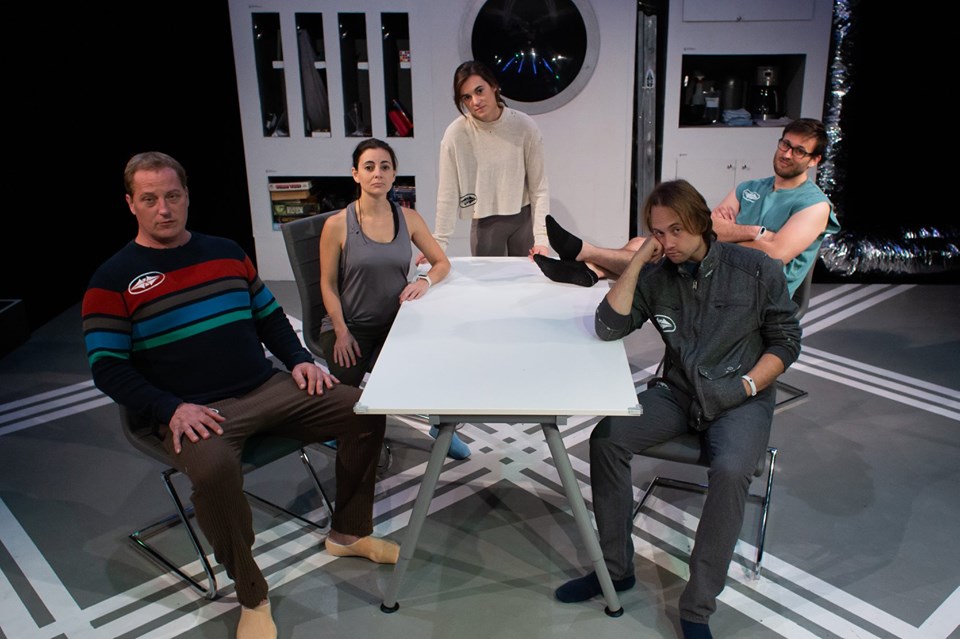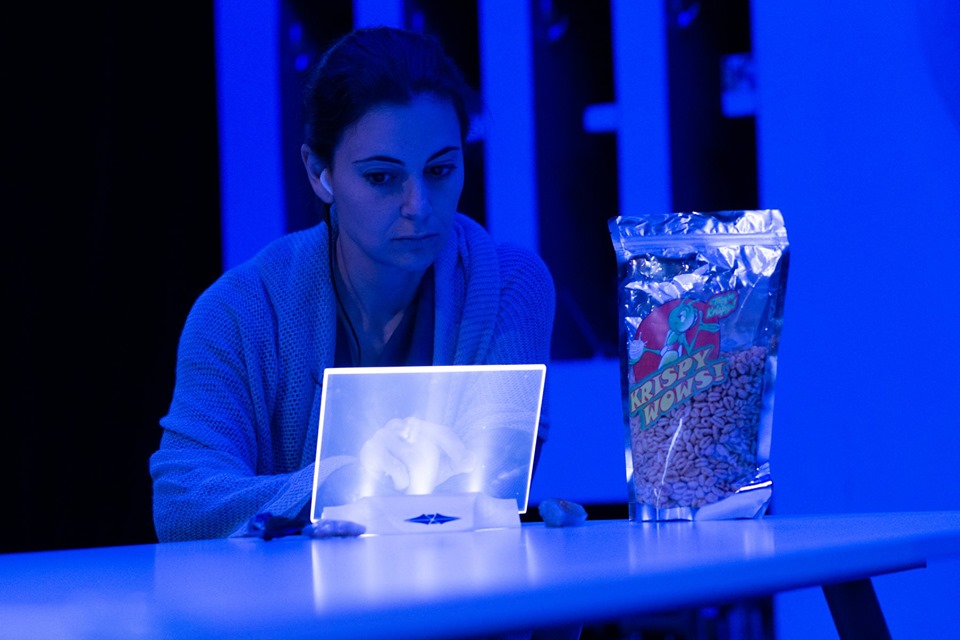
The cast; Photo by Jake Scaltreto.
Presented by Flat Earth Theatre
By Alistair McDowall
Directed by Lindsay Eagle
Dramaturgy by Dee Rogers
Violence and Movement Consultant: Sarah Gazdowicz
Scenic Designer: Darren Cornell
Costume Designer: Erica Desautels
Lighting Designer: Connor S. Van Ness
Sound Designer: Kyle Lampe
Special Effects Designer: Lynn Wilcott
Props Designer: Jake Scaltreto
Cast: Cassandra Meyer, David Anderson, Nick Perron, Slava Tchoul, Abigail Erdelatz
Nov. 1 – 16, 2019
The Mosesian Center for the Arts
321 Arsenal Street
Watertown, MA
Flat Earth on Facebook
Critique by Kitty Drexel
Trigger warning: gore, blood, violence, psychological horror
(Watertown, MA) Flat Earth’s production of Alistaire McDowall’s X is a mind fuck. This psychological horror-ballet with dripping blood, broken minds, and sleep deprivation won’t let its audience get away with mindlessly consuming a performance. Then it pounds into you so hard you’ll never forget.
Humans need other humans to function properly. The scientists of X are on a long-term, privately-funded mission to Pluto. Contact is lost with their base on Earth. All systems are running cleanly but no one is picking up the comm at the head office. The crew is isolated, maybe abandoned in the farthest reaches of explored space. The crew must devise a way to survive until help comes to get them. If help comes to get them. The base is designed to last decades beyond their mission but their minds are not. X explores the limits of the mind within the context of a deprived environment.
Alistair McDowall’s script is not intuitive to the viewer. Gilda (Cassandra Meyer) is our heroine and she is unreliable – or so her co-crew members say. Gilda might be emotional but it’s not as if her colleagues Ray (David Anderson), Clark (Nick Perron), Cole (Slava Tchoul), or Mattie (Abigail Erdelatz) are behaving normally. They’re all scared. But, fear levels are within the normal range of circumstances… Until they realize that the computer system that regulates their lives is not properly functioning. Suddenly, nothing is reliable. Playwright McDowall toys with us from the moments the lights went up.
Many studies have been conducted on the effects of sleep deprivation and extreme isolation. The human brain does not like long-term stress. The scientists in X try to acclimate to their extreme environment and fail spectacularly. Their minds cannot cope with the number of stressors their environment presents.
McDowall shows us these character fails with graphic depictions of self-harm, assault, and gore – all scientifically documented reactions to stress. McDowall traumatizes his characters for a reason. In X, these behaviors are metaphors for the mental Olympics occurring in the characters’ minds. There are no pointless exhibitions of blood or violence in this play.
Two group hallucinations are depicted with violent staging. (Specific details are left out of this critique to prevent spoilers.) The characters involved in the two separate scenes navigate the slippery slope that is their shared experience. They are mad-scene ballets out of a dystopian Philip glass-like experience. Our cast does a beautiful job of convincing us the audience that they are scientists uniquely unsuited to their situation, and that we’d be even worse off than they are in their place.

Krispie Wows were harmed in the making of this production; Photo by Jake Scaltreto
In the mad scenes, words are spoken, repeated in rhythm and exchanged for other words while actors stomp across the set with increasing desperation. Characters are trying to communicate with each other but their words, their stomping, their interrogations don’t make linear sense. They are glitches in the Matrix. Their memories are unreliable. Speech loses its meaning so the characters stop speaking. Time has no meaning. It’s intense and humbling to watch.
The second of the two ballets loses momentum halfway through. As is, it reads to the audience like a montage: a collection of moments from the characters’ shared experiences instead of an arced story. We understand that the ballet isn’t linear but we don’t know if it’s building to anything.
Choices must be made about what purpose the ballet serves and whittled appropriately. We’re ready to move on and the characters are halfway through their lunatic bacchanalia. The audience has invested in the characters, wants to know if they will achieve some semblance of okayness, but doesn’t have the patience to witness the entire silent ballet.
That being stated, the mad scene ballets appeared safe thanks to the efforts of director Eagle and violence and movement consultant Gazdowicz. The characters’ sanities were in question, but the physical healths of the actors weren’t.
The silent partners in X are the designers. Much of what makes this production eerily effective are the props, costumes, lighting effects and sound. Details such as the devised canned food labels, the glitchy wall clock, and the company insignia on the costumes create a specific location within X’s realty. The constant “woob woob” of the space lounge invokes Star Trek. The wound work and seeping blood stage effects were deeply creepy.
X imagines a potential future for mankind in which we have killed everything that isn’t human through gross negligence. MacDowall’s future is not unrealistic. As much as this play is about human behavior in extreme circumstances, it’s about us right now. We are the people creating an isolated existence for future generations. If x equals the unknown then the future of Earth isn’t x. Our future is extinction.
———————
On November 9, X will be preceded by a FREE production of New Work / New Worlds: “Satellite Futures” by Flat Earth Theatre and Catalyze Playwriting Group at 7 PM.
Works featured are:
Sculpin by Austin Hendricks
When the moon bus breaks down, a visiting terraformer and a veteran moon colonist consider the sort of habitat best for humanity.
Tardigrade Moon Rising by Carl Danielson
A group of evolved tardigrades on the moon must defend their land and water from imperialists from Earth.
Dear Pluto by Zach Barryte and dRachel Bowens-Rubin
“Dear Pluto” tells the tale of a burgeoning penpal friendship between a jaded minor planet and an excitable space satellite. It was inspired by the events of the NASA New Horizons mission that visited Pluto in 2015.
Cast for 11/9: Olivia Waring, Katie Labounko, Adam Strandberg, Masha Sten-Clanton, E. Rosser, Jenny Gutbezahl, David Olsen.
